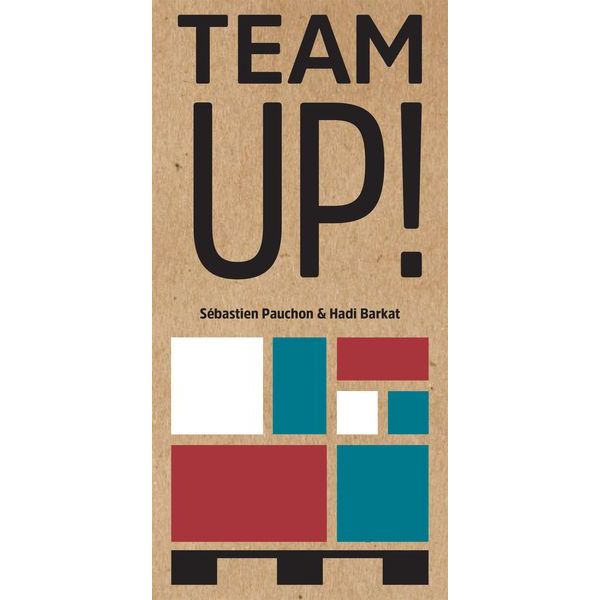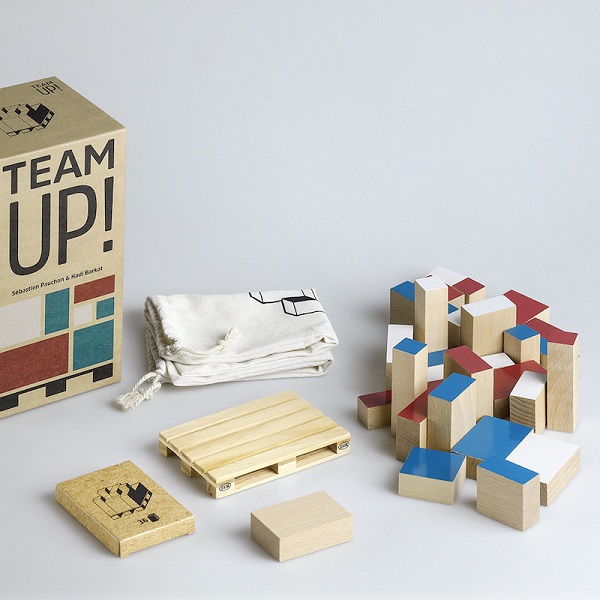How Do You Efficiently Pack and Stack Blocks? Team UP!

Team UP! is a cooperative stacking game from Helvetiq, in which players work together to place as many blocks as possible, as neatly as possible, onto a wood pallet.
Draw cards to determine which blocks must be added next and see how high a score you can reach while following a few stacking rules.
Gameplay
You place the wooden pallet in the center of the table and place the start block on it. The deck of cards is shuffled and set to one side, and the blocks are sorted by color. Blocks come in four shapes, and each block is colored along one side in white, red, or blue.
On your turn you draw a card. This shows either a color (in which case you can choose any block of that color), a shape (in which case you can choose a block of that shape regardless of color), or allows you to choose between two different shapes. You take a piece that matches the card and must add it to the pallet; however, there are a few placement rules.
When adding a piece to the pallet, it must touch at least one other block and the colored side must be face-up. The block cannot extend past the boundaries of the pallet, and when placing it on top of another block it cannot overhang any empty space on the pallet. Finally, you cannot place the block so that its side perfectly aligns with an identical side of another block of its same shape. (Note: this rule is written a little unclearly in the rulebook, but this is what we believe is most likely intended.)
If you add a piece successfully to the pallet, you lay the card you drew face-up. If you could not legally add a piece, you lay the card face down.
The game ends once all blocks have been added, there are no more cards left to draw, or players decide to stop (fearing that drawing more cards will simply lower their score).
Players then calculate their score. You earn five points for each layer of blocks that is completely filled in. You lose one point for each block not added to the pallet and one point for each of your face-down cards.

Review
Team UP! is at first deceptively simple. You start stacking and everything seems smooth sailing. It’s only as you go along that you realize that getting a high score is actually going to be more difficult and requires more planning than it appears at first. Since the cards give you some freedom in choosing your blocks, you need to plan ahead carefully if you don’t want a lot of face-down cards at the end.
It’s very much a game that you want to play again once you reach the end, convinced you can do better the next time. This ‘competing against yourself’ angle works well, given the fast gameplay.
You can return the cards to the exact same order you initially drew them in easily (the game even recommends you do so) if you want to directly go head-to-head with your previous score, and there is also a variant in which the game gives you a specific order to stack the cards in, so that you’ll draw them in an order in which they’ve confirmed you can get a perfect score. This still doesn’t make the game easy and you’ll still be plenty challenged to actually earn that score.
It doesn’t really matter much if you are playing it solo or with a friend. In fact, the maximum player count of four isn’t the game at its best and can too easily lead to someone dominating the game, however playing with a friend of a similar skill level would be a fun way to tackle the puzzle and it does also make for an excellent solo game.
We have played a number of games by Helvetiq, and are invariably impressed by the component quality. They’re often light on art but feature game pieces that are particularly fun to handle and play with. Team UP! is no exception. The wooden blocks are fun to stack, the pallet is great, and there’s even a cloth bag included to hold the pieces.
If you enjoy puzzles, Team UP! is a nicely executed one. It’s attractive, challenging, and does a great job at inspiring you to try again. The rules surrounding playing identical sides next to each other could be written a little clearer, but overall it’s a simple game with a complex puzzle at its heart.
Pros: Excellent component quality, approachable and replayable, good for 1-2 players
Cons: Not at its best with 3-4 players, one rule element is not written clearly
Disclosure: we received a complimentary review copy of this game.







